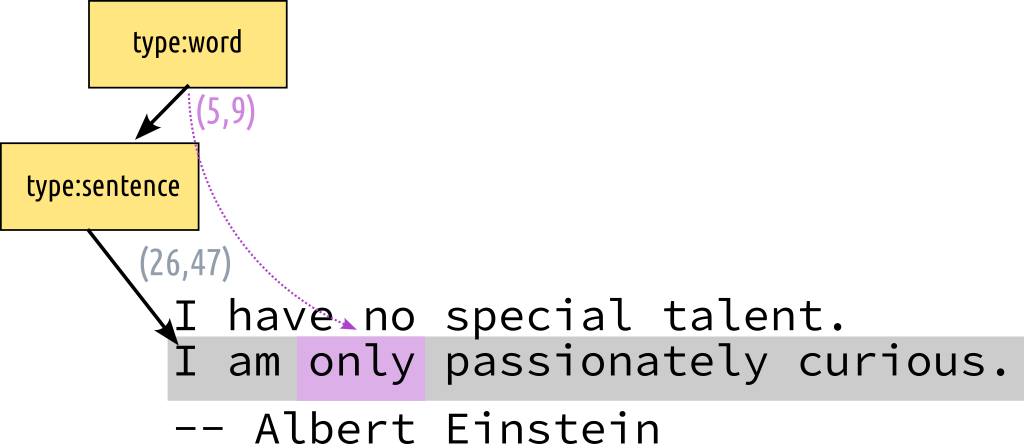I was thinking about "the importance of having a coordinate system independent
of what the source files offer" which @dirkroorda mentioned the other day, and
which was also described in the Unlocking Digital Texts Position
Paper:
From these formats, it is definitely possible to introduce a “glyph1-level” fragment addressing
scheme, comprising an offset from the start of the file. This effectively reduces all text
formats to plain-text by stripping away any additional tagging and non-textual components.
This is not an entirely trivial exercise, since some additional complexities around Unicode
normalisation rules and white-space handling will need to be dealt with, in order to ensure
that plain-text conversions are carried out in a consistent manner.
However, at this stage, it appears that it would be advantageous to also have a
higher level scheme that operates in a more “human-friendly” way, with word (or token)
granularity and some sense of semantic structure at a level similar to Markdown or a
light-TEI schema.
How does this relate to STAM? We have higher-order annotations that allows modelling higher-level schemes.
We can annotate a sentence and then annotate a word in that sentence using relative offsets:

The offsets still refer to the unicodepoint level, but no longer relative to
the resource as a whole but to the annotation that is being pointed at (the
sentence in this case).
The recent proposal for the STAM Baseoffset
extension is also relevant in this
because it allows us to use a start/base offset that deviates from the actual
text (a simple decoupling from the actual coordinate system, though the units
are still the same).
Next we also have our CompositeSelector (and MultiSelector) that would let us
model things the other way round, we can have the sentence be the higher-order
annotation and have it point annotations that are words, and those in turn point to the resource
(using offsets).
At this point a question arises of something we can't model in STAM yet. Our
offsets are always unicode points (as that's our most atomic unit). If you want
to address things at a higher level like described in the previous paragraph
then that requires explicitly enumerating all the targets in a
CompositeSelector/MultiSelector/DirectionalSelector. But what if we want to use
offsets in another coordinate system here? Say a selector that selects the
second up to the ninth word? Do we want a selector that can express this
whilst automatically interpolating the points in between?
Adding something like that should be possible and adds more flexibility to how
people can use STAM for modelling, but it comes at the cost of adding further
complexity to STAM. So probably it should be an extension.
Eventually we could even go as far as have a universal Selector that points to
something (resource/annotation) that is the result of a whole query. That might
subsume the above use-case as well, but would rely on several extensions (most
notably the query system which will be upcoming anyway) that are not trivial.
Text-Fabric and FoLiA both rely in the core on a coordinate system
more detached from the text, in both a text is merely an annotation like anything else.
The situation in STAM is a bit different, almost everything is an annotation
but the text itself is the primary thing an annotation points to (a slice
thereof), either directly or indirectly. I do think that's the proper method
for a standoff text annotation model.
Last, a word about complex selectors like those in the Web Annotation model
which can reference XPath and other complex file formats. I do consider these
explicitly out of scope for STAM. We want to untangle text and annotations
completely, so text is its most bare form (plain text, utf-8) and all
annotations reference that, rather than some hybrid.
I just wanted to throw all this out here to voice and hear some thoughts and if
needed have some discussion, I'm especially interested in what @dirkroorda
thinks.


